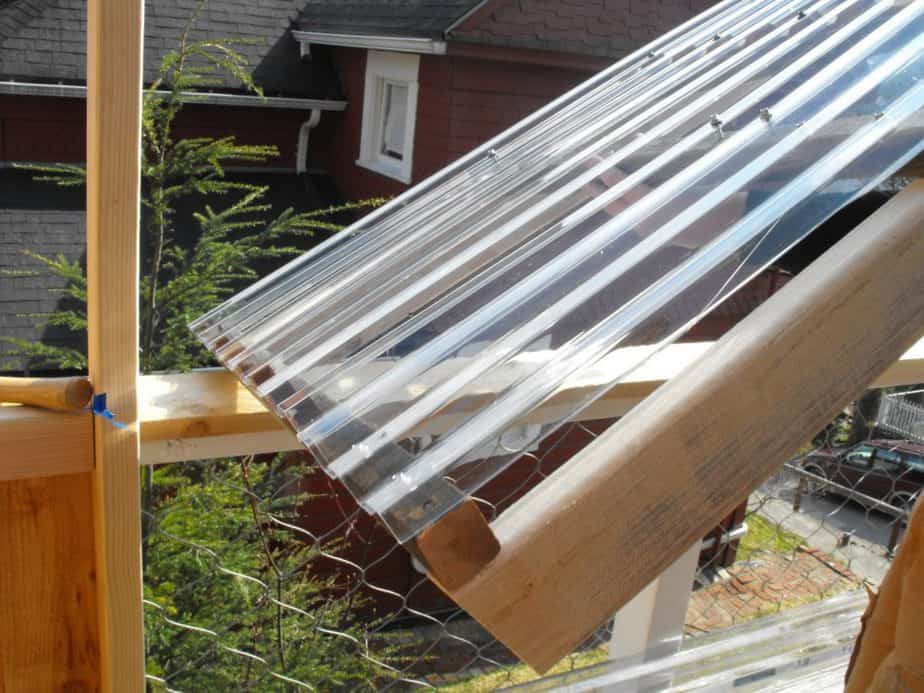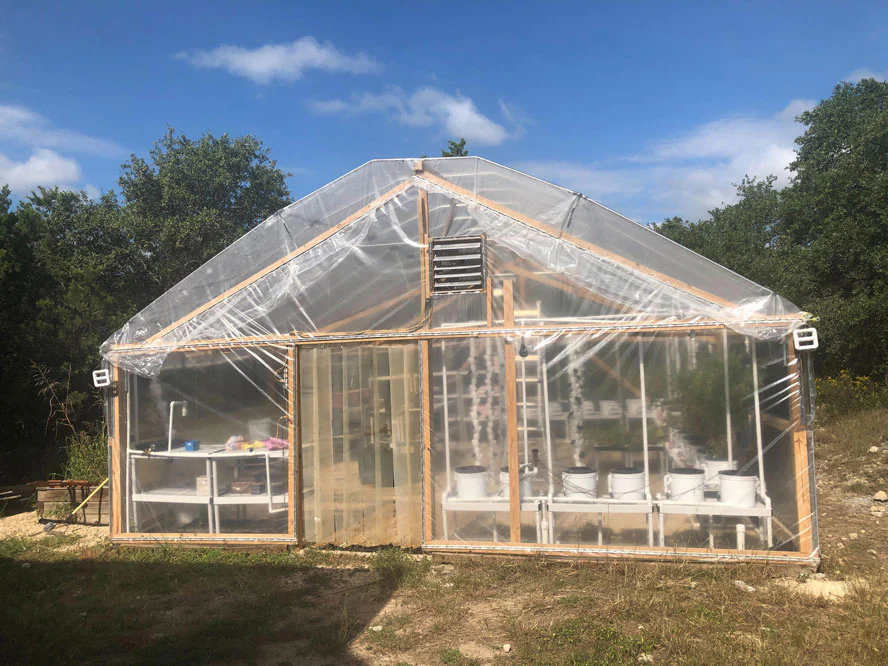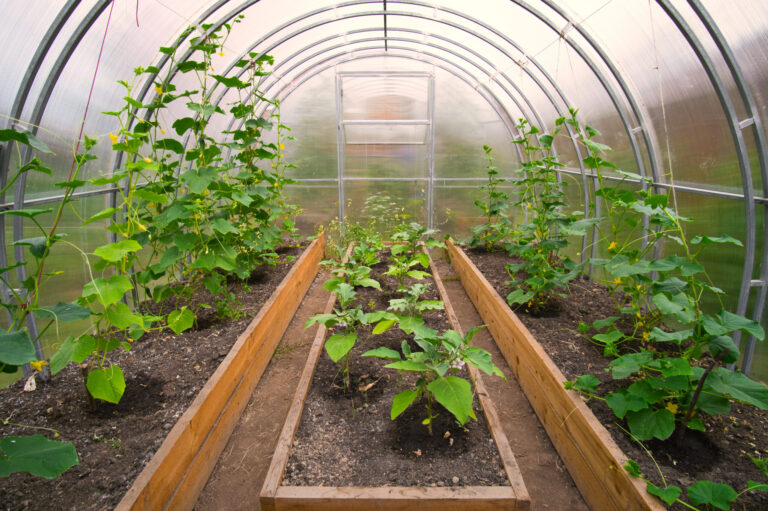Different materials are used for greenhouse roofs, each with its own benefits. Glass lets in lots of light and lasts a long time, but it can break easily and cost a lot. Polycarbonate is strong, and light, and keeps things insulated; plus, it comes in different thicknesses. Acrylic is like glass but lighter and tougher, though it can be pricier. Polyethylene film is cheap and okay for temporary greenhouses, but it doesn’t last long.
Fiberglass lasts well but might change color over time. PVC panels are light and not too expensive but might not hold up well in the sun. To pick the best one, think about things like how warm it keeps the greenhouse, how much light gets in, how long it lasts, how much it costs, how much care it needs, how it looks, and the local weather.
What are the Best Greenhouse Roofing Materials?

The unique characteristics, strengths, weaknesses, and considerations of each material is crucial in making an informed decision when selecting the appropriate roofing material for a greenhouse.
Glass
Glass offers exceptional light transmission, allowing ample sunlight into the greenhouse. It’s durable but can vary in thickness and quality. Clear glass provides the highest light transmission, while frosted or tempered options offer diffused light.
Advantages and Disadvantages
- Advantages: Excellent light transmission, durability, and aesthetic appeal.
- Disadvantages: High cost, susceptibility to breakage, potential heat loss, and varying insulation properties depending on thickness.
Polycarbonate
Polycarbonate is lightweight, highly durable, and provides good insulation. Its strength and impact resistance make it suitable for varying weather conditions. It’s available in different thicknesses, offering options for insulation levels and light diffusion.
Thickness Variations and Benefits:
Thicker polycarbonate provides better insulation and strength.
Multi-wall polycarbonate enhances insulation properties and diffuses light more evenly.
Acrylic
Acrylic shares similarities with glass in terms of light transmission but is lighter and more impact-resistant. It also comes in various transparency levels.
Unique Features
Acrylic is more impact-resistant than glass, making it less prone to breakage.
While offering similar qualities to glass, acrylic can be more expensive but is often preferred for its durability.
Polyethylene Film
Polyethylene film is a cost-effective option suitable for temporary or small-scale greenhouses. It allows light transmission but lacks durability compared to rigid materials.
While affordable, polyethylene film needs replacement over time due to wear and tear.
It provides decent light transmission but doesn’t offer the longevity of other materials.
Fiberglass
Fiberglass is durable and offers even light distribution, which helps prevent hotspots. It’s relatively lightweight and resilient in different weather conditions.
Potential Drawbacks
Fiberglass might discolor or become brittle over time when exposed to UV rays, impacting its appearance and longevity.
PVC Panels
PVC panels are lightweight, easy to install, and relatively inexpensive compared to some alternatives.
PVC panels may degrade over time when exposed to UV rays, leading to yellowing or brittleness.
What Impacts Greenhouse Roofing Material Selection?
Taking these factors into account will help in making a well-informed decision based on the specific needs, budget, and environmental conditions of the greenhouse location.
Insulation Capabilities
Evaluate the material’s ability to retain warmth within the greenhouse during colder periods. Consider how effectively the material prevents heat transfer, minimizing heat loss during cooler seasons. Materials like polycarbonate with multi-wall construction offer better insulation compared to single-wall options.
Light Transmission Properties
Assess the material’s ability to allow sunlight to pass through for optimal plant growth.
Some materials, like diffused polycarbonate, offer even light distribution, preventing hotspots and promoting uniform plant growth. In addition, consider whether the material provides UV protection to prevent plant damage from excessive sun exposure.
Durability and Longevity
Evaluate how well the material withstands weather elements like wind, rain, snow, and hail.
Consider the expected lifespan of the material without significant degradation or discoloration. Materials such as acrylic and polycarbonate tend to be more impact-resistant compared to glass or polyethylene film.
Cost-Effectiveness
Consider the balance between the upfront cost of the material and its lifespan and maintenance requirements.
Factor in potential replacement or repair costs over time to assess the material’s overall cost-effectiveness.
Maintenance Requirements

Evaluate how easy it is to clean and maintain the roofing material. Consider whether the material is prone to staining, degradation, or requires specific maintenance procedures.
Aesthetics
Consider the appearance of the roofing material and how it complements the overall aesthetics of the greenhouse. Materials like clear glass or transparent polycarbonate might be preferred for aesthetic reasons.
Local Climate Conditions and Suitability
Assess how well the material performs in extreme temperatures typical of the local climate.
Consider whether the material can withstand high winds or heavy snow loads prevalent in the area. Moreover, evaluate the material’s ability to handle intense sunlight or UV exposure without degrading quickly.
FAQ’s
What is a greenhouse roof?
A greenhouse roof refers to the covering or topmost part of a greenhouse structure designed to allow sunlight in while providing protection for plants inside.
What are the three types of green roofs?
The three primary types of green roofs are extensive, intensive, and semi-intensive, differing in the depth of soil, maintenance requirements, and the types of plants they can accommodate.
Are greenhouses typically made of PVC or polycarbonate?
Greenhouses can be made of various materials, but commonly, they use polycarbonate panels due to their durability, insulation properties, and light transmission.
What is the typical structure of a greenhouse roof?
The typical greenhouse roof structure involves a framework made of materials like aluminum or steel, supporting the chosen roofing material, such as glass, polycarbonate, or acrylic panels.
Why are green roofs constructed?
Green roofs are built to provide controlled environments for plants, allowing year-round growth, protection from harsh weather, and optimization of growing conditions for crops or plants.
Why are greenhouse roofs often curved?
Greenhouse roofs are curved to maximize sunlight exposure throughout the day, ensuring better light distribution for plant growth and reducing the risk of shadows in the structure.
Final Words
In conclusion, picking the right roofing material for a greenhouse is super important. You’ve got lots of options like glass, polycarbonate, acrylic, polyethylene film, fiberglass, and PVC panels. It’s essential to think about things like how warm it keeps the plants, how much light gets in, how long it lasts, how much it costs, how much care it needs, how it looks, and what the local weather is like. By considering all these factors carefully, you can make a smart choice that suits your greenhouse needs best. So, take your time, weigh the pros and cons, and pick the roofing material that fits just right for your greenhouse!

